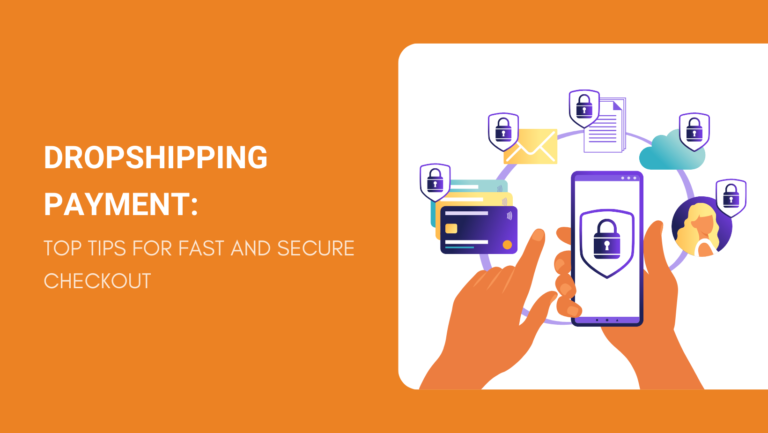Navigating the world of dropshipping can be challenging, especially when it comes to understanding the payment processes involved.
As a dropshipper, you should be well-versed in managing payments to ensure a seamless buying experience for your customers. Efficient payment processes are crucial for the success of your dropshipping business.
In this article, we will delve into the world of dropshipping payments, helping you better understand the various aspects involved.
From choosing the right payment gateway to dealing with currency conversion, our goal is to equip you with the knowledge and tools necessary to confidently navigate payments in dropshipping.

Understanding Dropshipping Payment Processes
When running a dropshipping business, it’s essential to understand how the payment process works. With a clear grasp of the payment procedures, you can ensure smooth transactions and provide a better shopping experience for your customers.
In the dropshipping model, you, as the retailer, don’t hold any inventory. Instead, you partner with a supplier who ships the products directly to your customers.
The payment process typically involves three parties: the customer, you (the dropshipper), and the supplier.
First, your customer adds a product to their cart and proceeds to checkout. Here, they enter their shipping information and choose a payment option such as a credit card or PayPal.
You need to offer various payment methods to cater to the preferences of different customers, thus enhancing their shopping experience.

Once the customer makes the payment, it is processed through a payment gateway and deposited into your account via a payment processor.
Popular payment gateways include PayPal and Stripe, while some e-commerce platforms like Shopify have their built-in processors.
As a dropshipper, your responsibility is to accept payments and forward the orders to your supplier. The supplier, in turn, takes care of shipping the products directly to the customers.
Establishing reliable communication channels with your supplier is crucial to ensure timely and accurate order fulfillment. Remember, customer satisfaction is vital in any business.
Be aware of potential chargebacks, which can occur when customers dispute a charge on their credit card or PayPal.
To avoid unnecessary chargebacks, maintain clear and transparent communication with your customers, provide accurate product descriptions, and establish an easy-to-understand return policy.
Payment Gateways vs Payment Processors
In the dropshipping business, managing payments is crucial. To make this process smooth and secure, you need to understand the role of payment gateways and payment processors.
Payment gateways are the services that handle the secure collection and verification of your customer’s credit card information during online transactions.
They bridge your online store and the payment processor, ensuring that every transaction is legitimate and encrypted. Some popular gateway examples include Shopify Payments, PayPal, and Stripe.

On the other hand, payment processors are the companies responsible for processing the actual transaction between your customer’s bank and your business’s bank account.
They manage the transfer of funds from your customer’s account to yours. Examples of payment processors are Square, Authorize.Net, and Adyen.
Here’s a comparison table to help you understand their key differences:
| Payment Gateway | Payment Processor | |
| Function | Securely collects and verifies customer payment information | Processes the actual transaction and transfers funds |
| Integration | Connects with e-commerce platforms and payment processors | Connects with banks and payment gateways |
| Security | Ensures transaction details are encrypted and secure | Handles funds transfer securely |
| Examples | Shopify Payments, PayPal, Stripe | Square, Authorize.Net, Adyen |
Tips on Choosing the Right Payment Gateway
When choosing the right payment gateway for your dropshipping store, consider the following factors:
1. Ease of Integration
You should look for a payment gateway that integrates smoothly with your e-commerce platform. For instance, Shopify provides its own Shopify Payments gateway, which can be easily set up and managed.
2. Global Transactions
Your payment gateway should support transactions from most countries. Ensure it can process global payments and transactions without any issues, as dropshipping often involves international sales.
3. Accepted Payment Methods
Find a payment gateway that supports a wide range of popular payment options, like PayPal, credit cards, and digital wallets. This way, you’ll cater to various preferences and needs of your customers.
4. Recurring Payments
If you plan to offer subscription-based products or services, make sure your payment gateway supports recurring payments.
5. Mobile Compatibility
Mobile shopping is becoming increasingly important today. Ensure that the payment gateway you choose provides a seamless mobile experience, allowing your customers to purchase easily from their devices.

6. Multi-Currency Support
To cater to a global audience, your payment gateway should support multiple currencies. This will allow customers to pay in their local currency, providing a more convenient shopping experience.
7. Customer Support
Look for a payment gateway with an excellent track record for customer support. Issues can arise, and a reliable support team is essential to help you through any problems.
8. Customization Options
You might want to customize the look and feel of your payment gateway to match your store’s branding. Choose a gateway that offers customization options, ensuring a seamless experience for your visitors.
9. Reliability and Uptime
Lastly, it’s important to choose a payment gateway that’s reliable and has a high uptime. This means they’re up and running most of the time, preventing any potential disruptions to your store’s revenue.
Dealing with Currency Conversion
Here are a few key points to consider to manage currency conversion effectively:
1. Currency Selection on the Store’s Website.
To make it easy for your customers, let them choose their preferred currency while browsing your online store. This can be done by adding a currency selector, allowing users to switch their view to the currency they are comfortable with.
2. Real-Time Exchange Rate Integration.
Providing real-time exchange rate updates is essential for accurate pricing and preventing confusion. Consider integrating your payment system with a reliable exchange rate API to fetch and display real-time rates on your store.
3. Display Prices in Local Currency.
Ensure that your store automatically detects the customer’s location and displays prices in their local currency. This can enhance their experience and increase the likelihood of a completed purchase.
4. Transparent Currency Conversion.
Always keep currency conversion transparent to build trust and avoid unpleasant surprises during checkout. Display the converted price in the user’s preferred currency throughout the checkout process to provide a clear view of the total cost.

5. Multi-Currency Payment Processing.
Partnering with a payment gateway that accepts multiple currencies will greatly benefit your dropshipping business. This enables you to seamlessly accept payments from customers around the world, without additional effort on your part.
6. Currency Conversion Fees.
Remember that currency conversion fees might apply when receiving payments in different currencies. Make sure to factor in these fees when setting your product prices to maintain your profit margins.
7. Offer Currency Options Strategically.
Focus on offering currency options for regions with the highest sales potential. Analyze your customer base and website traffic data to determine which currencies to prioritize.
8. Communicate Clearly with Customers.
Ensure that all currency-related information is clearly communicated to your customers, including currency conversions, exchange rates, and any additional fees.
A clear and honest communication strategy makes your customers feel more confident about purchasing from your store.
Automating Payment Processes
Automating payment processes offers a myriad of benefits for your dropshipping business. Let’s explore some of the advantages and the tools you can use to streamline payments and make the most of your store’s sales.

Benefits of Automating Payment Processes
- Efficiency and Time Savings. Automated payment processing saves time and effort, allowing you to focus on other aspects of your business.
- Reduced Errors and Improved Accuracy. Automation ensures accurate processing, minimizing the risk of errors and delays.
- Streamlined Order Fulfillment. Automated payments facilitate seamless transactions, improving your store’s order fulfillment process.
- Enhanced Security and Fraud Prevention. Payment gateways offer security features that protect your business and customers from fraud and data breaches.
- Customer Convenience and Retention. Offering various payment options contributes to a positive shopping experience and increases customer loyalty.
- Improved Cash Flow Management. Automation helps manage sales revenue effectively, keeping your business financially stable.
- Reduced Operational Costs. Minimizing manual intervention reduces labor costs and enables you to maintain a lean operation.
- Compliance and Auditing. Automated payment platforms comply with financial regulations, making it easier to conduct audits when needed.
Tools for Payment Automation
1. Stripe
Stripe is a popular choice for ecommerce businesses, offering a comprehensive platform for accepting and processing payments.
2. PayPal
Trusted globally, PayPal enables secure transactions through its user-friendly gateway, supporting various currencies.
3. Square
Square simplifies the payment process and offers a suite of tools to manage your business’ financial operations.
4. Braintree
As a PayPal service, Braintree supports a wide range of payment methods, making it convenient for customers and merchants.
5. Authorize.Net
Authorize.Net allows your dropshipping store to accept and process credit card transactions securely.
To further enhance your automated payments, consider using accounting and customer relationship management (CRM) tools such as Zoho Books, QuickBooks Online, Xero, HubSpot, and Salesforce.
For e-commerce platforms, Shopify and WooCommerce can be invaluable assets for your dropshipping business.
These tools help you manage your finances, maintain customer relationships, and create a seamless shopping experience, contributing to the overall success of your store.

Frequently Asked Questions
How Do I Pay Suppliers in Dropshipping?
When you start your dropshipping business, you will need to pay your suppliers for the products they ship to your customers.
Most suppliers accept various payment methods, such as credit cards, PayPal, and bank transfers.
It is essential to establish clear communication with your supplier and discuss the preferred payment method to ensure a smooth transaction.
Keep in mind that timely payments help maintain a good relationship with your suppliers and ensure the continued success of your dropshipping business.
What Are Common Pitfalls in the Dropshipping Payment Process?
As you navigate the payment process in your dropshipping business, you may encounter some common pitfalls that can arise. Some challenges to watch out for include:
1. Currency conversion. Suppliers might be based in different countries, so you must understand the currency conversion rates and account for possible additional fees.
2. Late payments. If you don’t pay your suppliers on time, they might delay shipping orders or even terminate their relationship with you.
3. Chargebacks and refunds. As a dropshipping seller, you should be prepared to handle chargebacks and refunds from customers. Make sure to have a clear refund policy and communicate with your suppliers how to address these situations.
Which Is the Safest Payment Method for Dropshipping Sellers?
Choosing the safest payment method for your dropshipping business is crucial, as it ensures the security of your transactions and minimizes potential risks.
While there is no one-size-fits-all solution, you should consider using well-known and trusted payment platforms such as PayPal, Stripe, or Shopify Payments.
These platforms offer secure payment processing and are widely recognized, which can help build trust with both your customers and suppliers.
Research and compare the features, fees, and terms of different payment methods to determine the best fit for your business and its unique needs.
As a dropshipper, it’s essential to understand the ins and outs of dropshipping payment processes. Efficient and secure payment processes will ensure both your customers and partners can trust your business.
Now that you have a better understanding of dropshipping payment processes, it’s time to implement secure and efficient systems in your store.
Integrate multiple payment methods in your store and accommodate a diverse range of customer preferences.
If you’re looking for a trusted partner to empower your dropshipping business, NicheDropshipping can be an invaluable resource. We offer comprehensive dropshipping services, including product sourcing and private labeling.
Don’t hesitate to request a free quote if you want to take advantage of our expertise and streamline your dropshipping operations.

